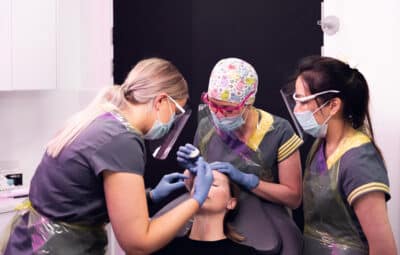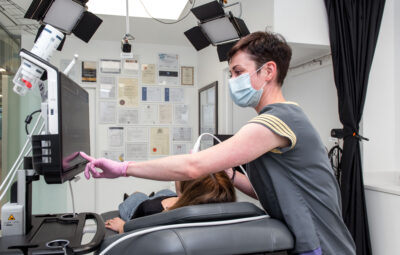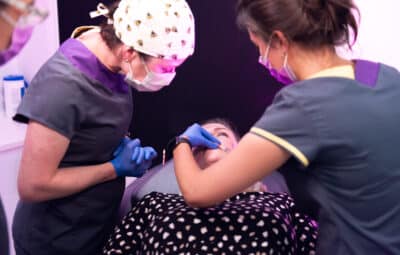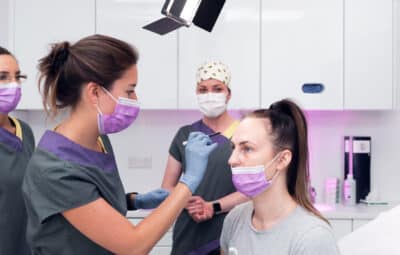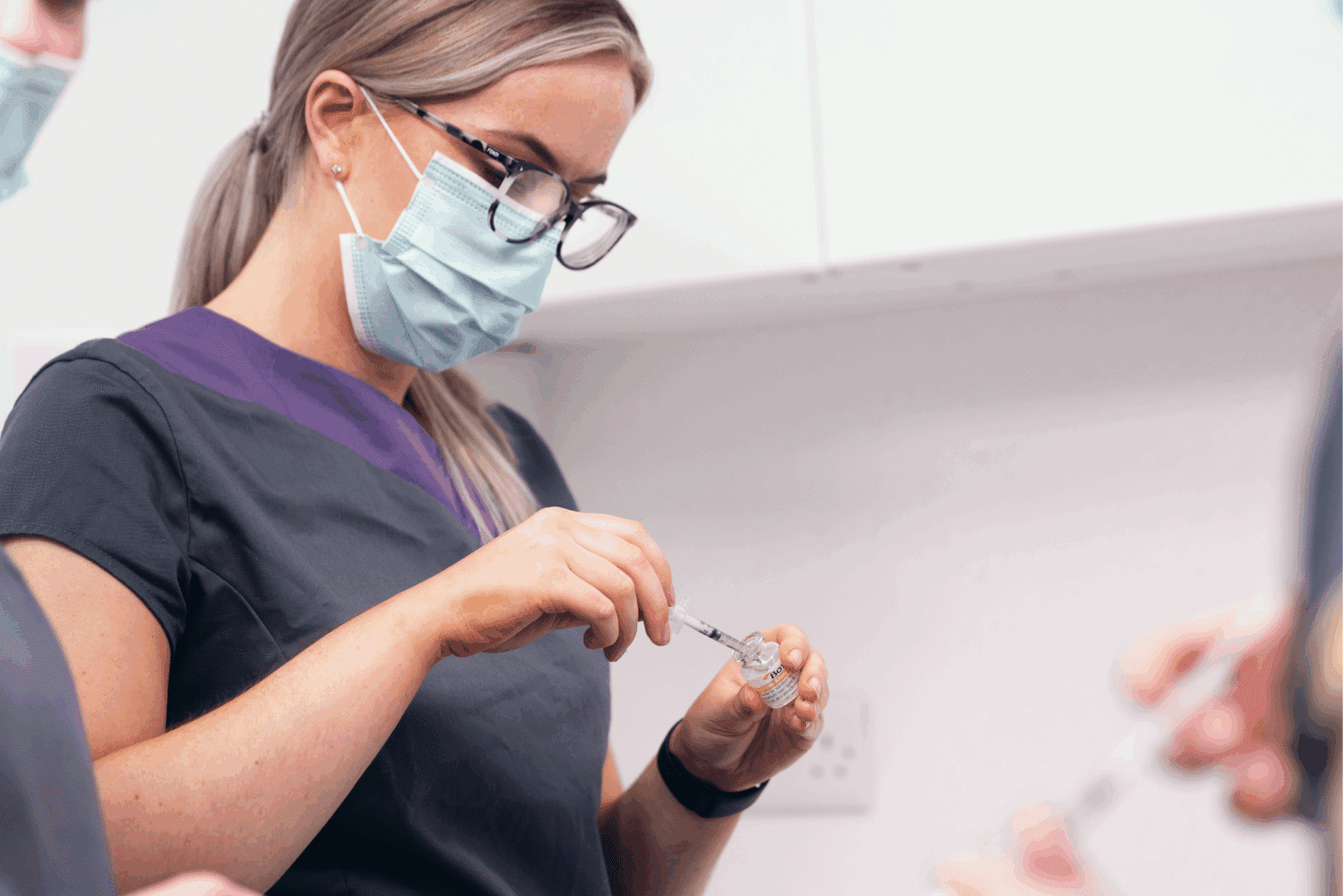
Gummy Smile Botox Injection Points | The Best Techniques
13 March 2025
In this post:
- Gummy smile correction with Botox is a minimally invasive alternative to surgery, targeting hyperactive upper lip muscles like the LLSAN.
- The Yonsei Point and Nasolabial Fold Points are the most commonly used injection points when performing gummy smile treatment.
- Key risks include over-relaxation of lip elevators (‘joker smile’), asymmetry, and speech/eating difficulties.
- Mastering gummy smile Botox requires a strong anatomical understanding and hands-on training.
A gummy smile is a cosmetic concern that can significantly impact a patient’s confidence and self-image. Fortunately, with the use of botulinum toxin (Botox) injections, there’s no need for anyone to suffer with a smile that makes them feel insecure.
Botox offers a minimally invasive, non-surgical solution that can dramatically improve the appearance of a gummy smile. Unlike complex surgical alternatives, these carefully placed injections can create a natural-looking result with minimal downtime.
For aesthetic injectors, mastering the precise gummy smile Botox injection points is essential not only for achieving optimal aesthetic outcomes but also for ensuring patient safety.
At the Smileworks Aesthetic Training HUB, we believe patient safety is paramount. Even small deviations in placement can lead to asymmetry, functional limitations, or inadequate correction. This expert precision is what separates skilled injectors from novices in the competitive field of aesthetic medicine.
This blog post is designed for medical professionals and aspiring injectors looking to perfect their technique, but we also hope it provides valuable insights for patients considering gummy smile botox. Understanding the underlying anatomy, specific injection points, and potential cases of botched Botox will help both practitioners and patients make informed decisions about gummy smile correction.

Understanding the Gummy Smile
In aesthetic medicine, a gummy smile (also known as excessive gingival display) is typically defined as the exposure of more than 3mm of gingival tissue when smiling. While some degree of gum visibility is normal and can even contribute to a youthful appearance, excessive display can create an unbalanced look that many patients want to correct.
What causes a gummy smile?
To effectively treat a gummy smile with Botox, injectors must first understand its underlying causes. This can vary from patient to patient. Some of the most common causes of a gummy smile are:
1. Overactive Upper Lip Muscles
The most common cause–and the one most responsive to Botox treatment–is hyperactivity of the upper levator muscles:
- Levator labii superioris alaeque nasi (LLSAN): This muscle originates at the frontal process of the maxilla and inserts into the upper lip and alar cartilage. It’s the primary contributor to excessive gum display.
- Levator labii superioris (LLS): This muscle runs from the infraorbital margin to the upper lip and works in concert with the LLSAN.
- Zygomaticus minor: This muscle extends from the zygomatic bone to the upper lip and contributes to lip elevation, particularly when smiling.
2. Skeletal Factors
- Vertical maxillary excess (VME): An overgrowth of the maxilla creates a longer middle third of the face, resulting in greater gum exposure.
- Protrusion of the anterior teeth or dentoalveolar extrusion.
3. Lip Abnormalities
- Short upper lip: An anatomically short upper lip (less than 20-22mm in women or 22-24mm in men).
- Hypermobile upper lip: Excessive movement of the upper lip when smiling
The Importance of Proper Diagnosis
Before administering Botox, a thorough consultation is crucial. Practitioners must determine whether the gummy smile stems from muscular, skeletal, or lip abnormalities. This diagnosis will inform not only whether Botox is appropriate but also the specific injection technique required.
For cases with significant skeletal components, Botox alone may not provide sufficient correction. Adjunctive treatments or a referral to an oral-maxillofacial specialist might be necessary. A patient’s satisfaction ultimately depends on proper treatment selection based on an accurate diagnosis.
What is Gummy Smile Botox?
Gummy smile Botox is the treatment most patients will turn to for correcting their gummy smile. It is considered an advanced Botox area and requires special training to inject. Botulinum toxin type A works by blocking the release of acetylcholine at the neuromuscular junction, temporarily paralysing or weakening the targeted muscles. When injected into the lip levator muscles, Botox reduces their ability to contract forcefully during smiling, resulting in less gingival display.
This chemodenervation effect is precise and localised, allowing experienced injectors to create natural-looking results without affecting normal facial expressions or function when properly administered.
Treatment Timeline
Patients can expect:
- Initial results: Noticeable improvement within 3-4 days
- Peak effect: Full results visible by 14 days
- Duration: Effects typically last 3-6 months, though this varies based on individual metabolism, dosage, and muscle strength
Advantages Over Surgical Options
Botox offers several advantages over surgical interventions:
- Minimally invasive with no downtime
- No permanent alteration to facial structures
- Adjustable results that can be refined over multiple treatments
- Significantly lower cost compared to surgical options
- Reversibility as effects naturally wear off
- Testing ground for patients considering more permanent corrections
Gummy Smile Botox Injection Points
There are several gummy smile injection techniques available, and which you choose is down to personal preference. We’ll discuss two of the most popular ones, both of them two-point injection techniques.
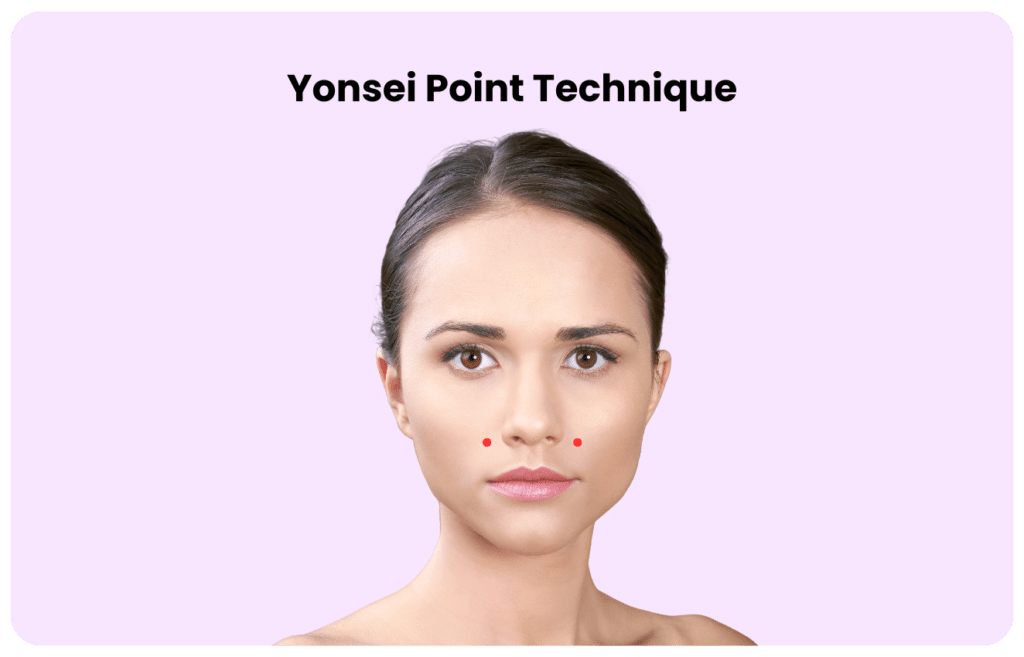
The Yonsei Point Technique
The Yonsei Point technique, named after Yonsei University in South Korea where it was developed, is a precise 2-point method that targets the convergence of the primary muscles responsible for gummy smiles.
Two injections are made at the Yonsei point on both sides of the face. The Yonsei point is located at the intersection of:
- A horizontal line drawn from the alar base
- A vertical line drawn down from the pupil
- Approximately 1cm lateral and 1cm superior to the alar base on each side
Typically 2-3 units of Botox will be used per side, though this could be adjusted based on:
- Muscle strength (assessed during dynamic examination)
- Severity of gingival display
- Patient’s previous response to treatment
- Gender (male patients may require slightly higher dosages)
Injection depth is superficial to mid-dermis (2-3mm depth).
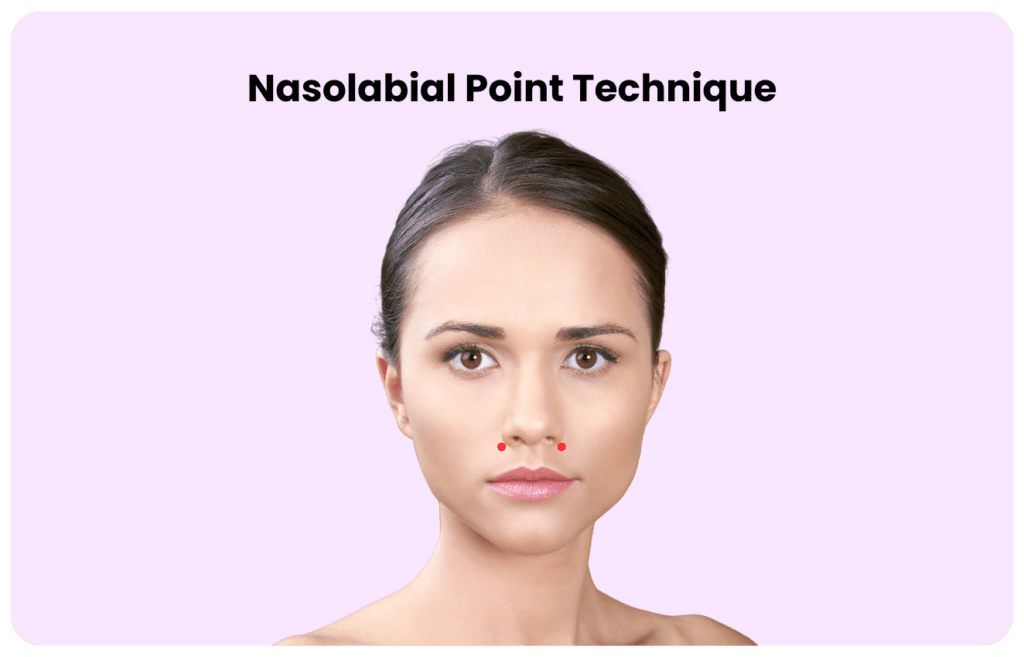
Nasolabial Fold Technique
Another common technique is injecting the Botox bilaterally at the nasolabial fold. Each injection is placed approximately 5-6mm lateral to the alar base. These injections target primarily the LLSAN muscles.
2 units of Botox per side are usually required for a subtle correction for mild cases.
Benefits of this technique include:
- May be preferred for patients with primary elevation in the central portion of the upper lip
- Reduced risk of over correction and altered smile dynamics
- Sometimes used in conjunction with Yonsei point injections for comprehensive correction
Tailoring Technique for Individual Patients
Standard techniques may need modification for:
Asymmetrical Gummy Smiles: Unilateral muscle hyperactivity may require different dosing on each side. Additional points may also be necessary to address localised elevation.
Deep Nasolabial Folds: Consider adding injection points at the superior aspect of the nasolabial fold. Be sure to use conservative dosing (1-2 units) to avoid excessive relaxation.
Lateral Gingival Display: Additional injections targeting the zygomaticus minor (1-2 units). These will be placed 1cm laterally to the main Yonsei point, if using the Yonsei Technique.
Adjusting Dosages Based on Muscle Hyperactivity
The concept of a ‘start low, go slow’ applies particularly well to gummy smile treatment. Here’s a general timeline guide to follow:
- Initial treatment: Conservative dosing (2 units per side)
- Assessment at 2 weeks: Determine if touch-up if needed
- Subsequent treatments: Gradual increase in dosing if needed
- Maximum recommended total dose: 10 units for gummy smile correction
Botox Gummy Smile Before and After
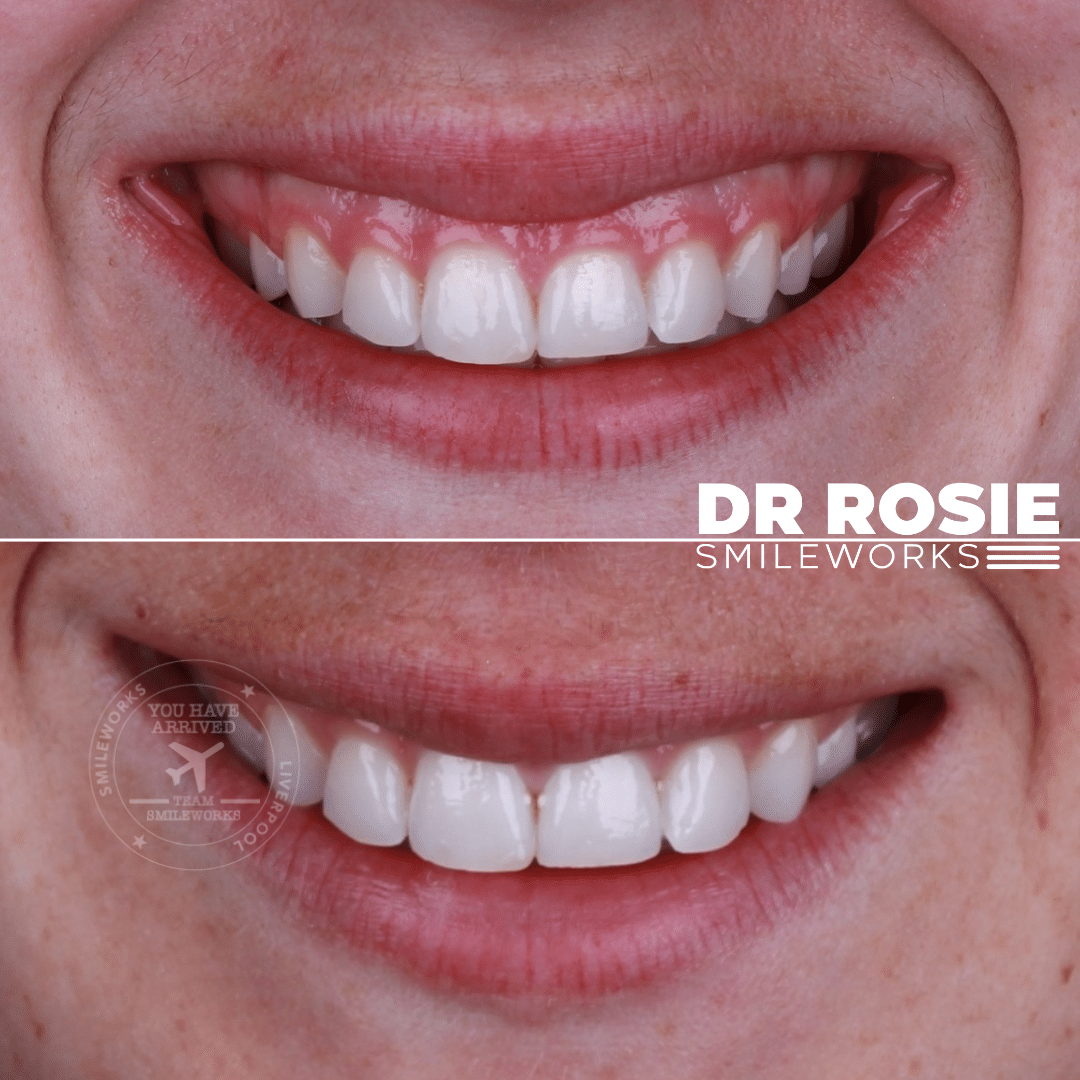
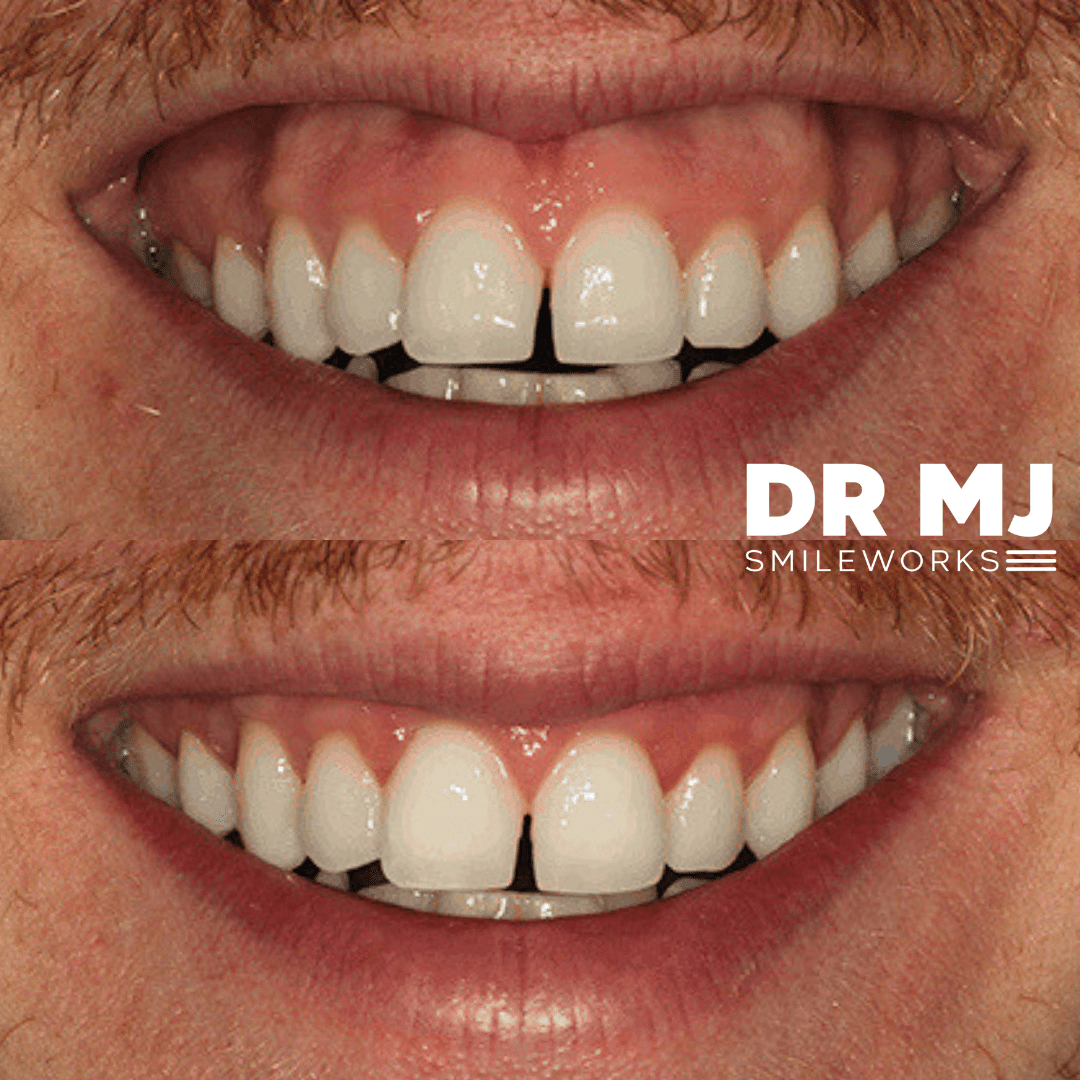
Common Complications & How to Avoid Them
‘Joker Smile’ (Over-relaxation of lateral lip levators)
This happens when an injector gives a patient too high of a dose. It can also occur when the product diffuses to the zygomaticus major or if the injection is placed too laterally.
To prevent this, be conservative in your dosing, especially when injecting laterally. Proper placement according to anatomical landmarks is crucial. Pay attention to your Botox as well. Is it highly concentrated? This minimises risk of diffusion. Also consider the nasolabial fold technique for patients who are higher-risk.
Uneven Smile or Asymmetry
When the dosing on each side is unequal, you risk smile asymmetry. An uneven smile can also happen when you don’t take into consideration any natural anatomical asymmetry the patient might have. Most faces are not fully symmetrical, so this needs to be accounted for when treatment planning.
To avoid smile asymmetry, be sure to spend time carefully assessing the face before injecting. Taking photos of the smile at rest and at a full smile can also help. Some injectors find it helpful to mark their injection points before administration to ensure the accuracy.
Impact on Speech and Eating
Too much Botox, and there’s a risk of impact on a patient’s speech and eating. Signs of this are if a patient has difficulty pronouncing labial sounds, drools when they drink liquids, and has altered smile mechanics.
This can be easily avoided by starting with conservative dosing. Patients should always be made aware of the risks for any side effects, no matter how rare they might be.
Pre-Treatment & Aftercare Advice
For Injectors
During the consultation and before treatment, you should take a photo of the smile at rest and an exaggerated smile. Other factors to take into consideration are the measurements of gingival display in millimeters, muscle strength, lip length, and skeletal factors.
For the actual treatment, we recommend using insulin syringes (30g or 32g) for precise placement. When injecting, be sure to consider dilution ratios. Lower dilution minimises risks for diffusion. You should also make sure you maintain injection depth. Too deep or too shallow can cause complications.
Keep in mind that in the UK, Botox is classified as a prescription-only medicine. However, who can inject Botox is currently unregulated. If you are not a prescriber, you’ll need to either obtain your prescribing qualification or work with someone who can prescribe.
For Patients
During treatment, you may experience a stinging sensation. This is completely normal and nothing to worry about. Gummy smile Botox is a quick procedure. The actual injection won’t last any longer than five minutes.
Don’t expect results right away. You won’t see the Botox start to work until about three days in, with full results in two weeks.
As for Botox aftercare instructions, avoid touching or massaging the area for four hours after treatment. It’s also best to avoid any strenuous exercise for 24 hours as well. Your injector will invite you back for a follow-up assessment after two weeks, where they’ll take a look at your progress and provide any top-up treatment you might need.
If you experience any unusual symptoms, tell your injector right away.
Gummy Smile Botox: Who’s a Good Candidate?
The best candidates for Botox gummy smile correction include:
- Patients with primarily muscular causes (hyperactive lip levators)
- Those with mild to moderate gingival display (3-6mm)
- Individuals with realistic expectations about results
- Patients seeking temporary correction or a ‘trial’ before considering surgery
- Testing ground for patients considering more permanent corrections
- Those who cannot undergo or wish to avoid surgical intervention
You might not be a good candidate if you are currently pregnant or breastfeeding, have a neuromuscular disorder (myasthenia gravis, Lambert-Eaton syndrome, etc.), have a known allergy to Botox, or have an active infection at the injection site.
Botox for Gummy Smile: Next Steps
Mastering the precise gummy smile Botox injection points is important for any aesthetic practitioner. When performed with a comprehensive anatomical understanding, technical precision, and appropriate patient selection, this treatment provides natural-looking results that significantly boost a patient’s self-esteem.
For injectors seeking to perfect their gummy smile Botox technique, comprehensive hands-on training is essential. At the Smileworks Aesthetic Training HUB, we offer specialised courses that cover facial anatomy for aesthetics, injection techniques, and complication management specifically for treatments like gummy smile correction. Our small-group training ensures personalised attention to develop your skills with confidence.
For patients considering gummy smile correction, consulting with a properly trained medical professional is crucial. At our aesthetics clinic Smileworks Liverpool, we correct gummy smiles every single week. Our injectors perform a thorough assessment, discuss realistic expectations, and create a customised treatment plan for your unique smile. With expert care, Botox can provide a subtle, natural-looking improvement to your gummy smile without surgery or downtime.

Learn From The UK’s Best Injectors
For the best gummy smile Botox training in the UK, there’s no better place than the Smileworks Aesthetic Training HUB. The HUB is an esteemed aesthetic training centre based in the UK. We pride ourselves on our wide range of online and hands-on courses tailored for every skill level.
The best starting point for gummy smile correction training is our renowned online Botox course. This is followed by a rigorous hands-on training day with the skilled and experienced Nurse Leah. All of our courses are designed specifically with medical professionals like doctors, dentists, and nurses in mind. You’ll walk away with the skills and knowledge necessary to start practicing on real patients right away.
For those looking for more in-depth gummy smile Botox training, we recommend booking a one-to-one mentoring session with Dr MJ. These sessions at 100% customisable, and you’ll receive personalised instruction based on your skill level and goals.
We also have a gummy smile Botox module included in our brand new Advanced Facial Ultrasound Course, where you’ll get to learn Dr MJ’s preferred technique. Regardless of your experience, the HUB has the expertise and courses to suit your needs.
It’s time to embrace the prospering world of aesthetic medicine. The HUB provides you with all the right training and guidance you need to succeed. Take control of your professional journey and step into a future filled with endless potential and opportunities.
Join us at the HUB. Let’s shape the future of aesthetic medicine together and ensure safe, effective, and transformative results for every patient.
Want to try out our courses before committing? Take advantage of our free trial for a taste of what learning at the HUB is like.
Related blog posts:

